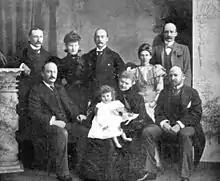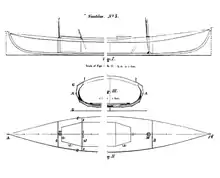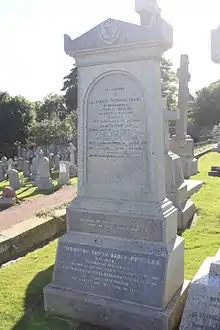Warington Baden-Powell
Henry Warington Smyth Baden-Powell KC (3 February 1847 – 4 April 1921), known as Warington within the family, was a British master mariner, canoeist, and admiralty lawyer.[1] The oldest full brother of Scouting pioneer Robert Baden-Powell (there was an older half-brother, Baden Henry Powell), Warington Powell was instrumental in the founding of Sea Scouting.
Warington Baden-Powell | |
|---|---|
 Monument to Warington Baden-Powell at Gilwell Park, the Scout Association's national headquarters in Essex. | |
| Born | 3 February 1847 |
| Died | 4 April 1921 (aged 74) |
| Known for | Sea Scouting, Canoe sailing. |
| Family | Baden Powell, Robert Baden-Powell, Agnes Baden-Powell, George Baden-Powell, Frank Baden-Powell, Baden Baden-Powell |
Life

He was born Henry Warington Powell in New College Lane, Oxford; the son of Reverend Professor Baden Powell, who held the Savilian Chair of Geometry at the University of Oxford from 1827 to 1860, and of Henrietta Grace Smyth, the third wife of Baden Powell (the previous two having died), who was a gifted musician and artist. Warington was the eldest child of the marriage, his siblings were George Baden-Powell, Robert Baden-Powell, Frank Baden-Powell, Agnes Baden-Powell, and Baden Baden-Powell.[2] Warington was educated at St Paul's School, London, which he entered in 1857.[3] In 1860, his father died, following which his mother changed the family surname from Powell to Baden-Powell in his memory.[4]
In 1861, aged 14, Warington joined the training ship HMS Conway as a cadet. He completed his training there in 1864 with a creditable Double Extra Certificate, and then accompanied his uncle, Captain Henry Toynbee, on a voyage on the East Indiaman, Hotspur. Following that, he joined the Peninsular and Oriental Steam Navigation Company as a 4th officer.[5] Early in his career he qualified as a Master Mariner and was commissioned a Lieutenant in the Royal Naval Reserve. Being the eldest son made Warington financially responsible for maintaining his mother's household, which was probably his motivation for leaving the sea in 1873 and starting legal training.[6] He was called to the Bar in Trinity Term 1876, being admitted as a barrister of the Inner Temple. He was later admitted to the Admiralty Bar and became a member of several important organizations focused on the sea. He was appointed a King's Counsel (KC) on 24 December 1897.[7] On 13 September 1913, Warington married New Zealand-born Cicely Hilda Farmer (known as Hilda) at All Saints, Knightsbridge. He had been secretly engaged to Hilda for nearly twenty years.[8]
He was elected as a Fellow of the Royal Geographical Society (FRGS). He also held membership in The Shipwrights' Company, the Yacht Racing Association and the Athenaeum Club. He was elected an Associate of the Royal Institution of Naval Architects in 1889.[9]
Warington died in Chelsea on 4 April 1921 but is buried in the Eastern Cemetery at St Andrews in Fife on the upper terrace, in his wife's family plot.[10] A portrait can be found on the Internet.[11]
Canoe sailing


From his childhood, Warington Baden-Powell had been an enthusiastic sailor of small boats and later became a pioneer of sailing canoes, which he designed himself based on the "Rob-Roy" type of hybrid canoe-kayaks which had been built by John "Rob Roy" MacGregor. In July 1869,[12] accompanied by a companion known only as "H", possibly his brother Baden Henry, Warington undertook a canoeing expedition in the Baltic Sea, and published an account of his adventures in 1871.[13] He was an early member and promoter of the Royal Canoe Club which he had joined in 1874. By the late 1870s, sailing canoes were taking part in organised racing, and providing keen amateur sport at reasonable cost at a time when yachting was an activity for the wealthy.
The Encyclopædia Britannica Eleventh Edition mentions him in the 'Canoe' entry:
W. Baden Powell modified the type of the "Rob Roy" in the "Nautilus", intended only for sailing. From this time the two kinds of pleasure canoe—paddling and sailing—parted company, and developed each on its own lines; the sailing canoe soon (1882) had a deck seat and tiller, a smaller and smaller cockpit, and a larger and larger sail area, with the consequent necessary air and water-tight bulkheads in the hull.
In 1872, Warington took his brothers, including the 15 year-old Robert, on an expedition by canoe up the Thames to its source and then on to the River Severn and the River Wye. There followed several other family expeditions in southern England which made a deep impression on Robert, who later recalled that Warington had "infused so much jollity and romance into that early sea-training that it gripped me from the first".[14]
In 1886, the American Canoe Association challenged the Royal Canoe Club to a sailing race and accordingly, Warington travelled to the United States with Walter Stewart and their canoes for the ACA annual meet at the Thousand Islands in the Saint Lawrence River. However, the heavy British general-purpose cruising canoes were beaten by the Americans who had developed specialised racing boats.[15]
Sea Scouts
Robert Baden-Powell had founded the Scout Movement in 1907 with an experimental camp on Brownsea Island which had included boating activities. In 1909, a further experimental Scout camp was held at Buckler's Hard in Hampshire which included extended experience aboard the training ship TS Mercury, and in October 1910 The Boy Scouts Association authorised the establishment of a Sea Scout Branch. Robert asked his brother Warington to write a manual for Sea Scouts; this included the details of the new training scheme which Warington devised jointly with Lord Charles Beresford who had been appointed Chief Sea Scout.[16] In June 1912, Sea Scouting and Seamanship for Boys was published. Warington himself admitted in his preface that the book could provide only an overview of boating skills required and perhaps for that reason, the Association published Seamanship for Scouts by Stuart Garnett shortly afterwards. However, Warington's book remained in print until 1949. The time pressures of Warington's legal career, and later the tuberculosis which led to his death in 1921, prevented Warington from taking a more active role in Sea Scouting.[14]

To commemorate the centenary of Sea Scouting, an international thanksgiving service was held on 16 August 2009 at the Church of The Holy Trinity in St Andrews, followed by a wreath laying ceremony at Warington's grave.[17] In 2011, a Sea Scout Group of the Portuguese Corpo Nacional de Escutas based in The Azores, named their 16-metre sailing yacht Almirante Warrington Baden-Powell in his honour.[18] In 2012, a bronze bust of Warington was unveiled by Edward Baden-Powell, the great grandson of Sir George Baden-Powell, at The Scout Association's national headquarters at Gilwell Park in Essex.[19]
Published works
- Canoe Travelling: Log of a Cruise on the Baltic, and Practical Hints on Building and Fitting Canoes (London: Smith, Elder, 1871)
- Sea Scouting and Seamanship for Boys (Glasgow: Brown, Son & Ferguson, 1912)
References
- Chuck Wills (2010). Boy Scouts of America: A Centennial History. p. 58.
- http://lachlan.bluehaze.com.au/1860-essays-reviews/powellfamilytree.html
- "Henry Warington Smyth Baden-Powell". www.halhed.com (via archive.is). Halhed Genealogy. Archived from the original on 18 January 2015. Retrieved 27 January 2019.
- Harris, Steven (2016). Meet the Baden-Powells. London: Lewarne Publishing. p. 7. ISBN 978-0-9926197-3-2.
- Harris p. 17
- Harris p. 18
- Sainty, John (1987): A List Of English Law Officers, King’s Counsel and Holders Of Patents Of Precedence. Selden Society Supplementary Series Vol. 7. Selden Society, London. p.151.
- Harris pp. 19-20
- Transactions of the Royal Institution of Naval Architects: Volume 30. 1889. p. 143.
- Harris pp. 20-21
- http://lafayette.org.uk/bad4407a.html
- Baden-Powell 1871 p. 3
- Harris p. 19
- Walker, Colin. "The Early History of Sea Scouting". history.scoutingradio.net. Retrieved 28 January 2019.
- Raffan, James; Horwood, Bert (1988). Canexus: The Canoe in Canadian Culture. Toronto: Betelgeuse Books. p. 68. ISBN 0-9690783-5-8.
- "History of Sea Scouting". www.scoutsrecords.org. The Scout Association Archive Department. Retrieved 28 January 2019.
- Brittain, Frank. "Sea Scouting Centenary". www.hertfordshirescouts.org.uk. Hertfordshire Scout Council. Retrieved 28 January 2019.
- Cordeiro, Christina (19 May 2014). "The Almirante Warrington Baden-Powell – The Story of a Sea Scout Yacht in the Azores". euroscoutinfo.com. European Scout Region of the World Organization of the Scout Movement. Retrieved 8 February 2019.
- Harris p. 122